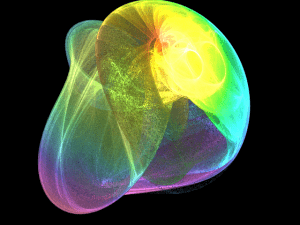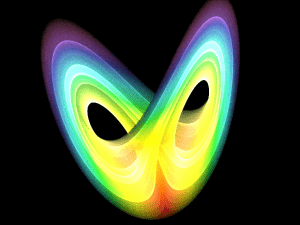I admit it, I succumbed. I finally decided to bite the bullet and start a real blog. Of course, a real blog needs a name. After a period of brainstorming, I decided to name the blog Strange Attractors.
What is a strange attractor? An attractor is a mathematical concept which refers to the limits to which a dynamical system may evolve over time. A simple example of an attractor is a damped pendulum. No matter the (finite) starting energy, the pendulum will slow down and eventually stop, making its resting point a fixed attractor. There are several kinds of attractors of which the most fascinating, and probably most beautiful, is the strange attractor. Again, without rigor, these are systems in which we have not found, or have proven that there cannot be found, a true equilibrium state—there is no cycle or period in which the system will repeat—yet patterns emerge. More rigorous definitions exits for those interested.
Thus the name of the blog; it represents the inevitable chaos of my postings—both topically and temporally—yet hopes for beauty to emerge nonetheless. Now that the blog had a name, I wanted an image of a strange attractor that was both chaotic and beautiful, and that is how I stumbled across Chaoscope. Chaoscope is a freeware 3D strange attractors rendering software. They have a galleries of images, but as their FAQ clearly states that images generated with the software are owned by the user, I decided to play and create my own images so I would not have to worry about copyright problems. It only took a short while to generate the image in the header. Another feature of the software is its animation function. Besides rendering static views of the attractors, it can animate the paths over time. A fascinating piece of software which I can see myself having fun with for a while.
As for this blog, I’m not sure how often or on what topics I will post, but suggestions, corrections, compliments, constructive criticism, or comments are always appreciated! I’ll leave you with some examples of beautiful images that arise out of chaotic mathematics; enjoy!




Ah! I am looking for some example R code to use to create Test Datasets with variable numbers of sinks in timeseries data, from 1 to n (n typically being less than 6). I found some Mathematica code that models a magnetic pendulum freely swinging between magnets, but I don’t know how to create the R from that.
So far I’ve been using Duffing Data – but that only comes with two sinks. As you might have guessed, I’m pretty much a beginner at Maths!
If you have some readily available, could you point me towards it?
In Linux.
OK – ChaosScope gives Ubuntu 15.04 a warning not to install, but I ignored that, and it (AFAIK) works. R code would be better if you have any, though, as I want configurable input data.